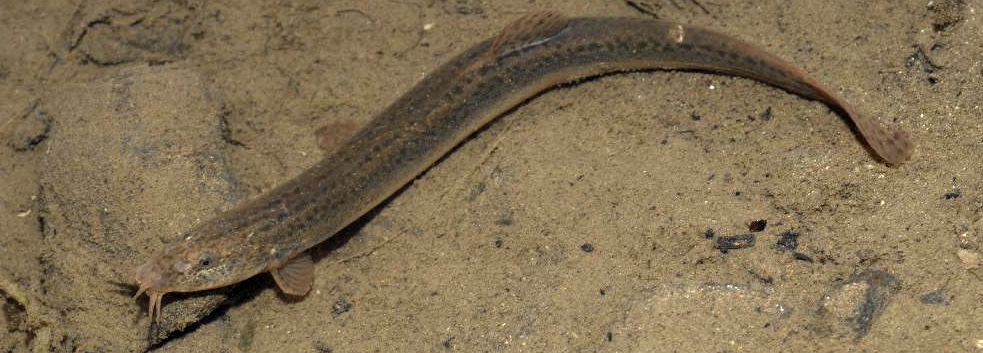ANIMAL: Oriental Weather Loach/Oriental Weatherfish/Dojo Loach Misgurnus angullicaudatus Type of Animal: True Loach Habitat: Thrives on mud/silt/sand/cobble/pebble/gravel/detritus substrates & prefers still/slow-moving waters-aquatic macrophyte beds, rivers, paddies, rice fields, ditches, streams, swamps, oxbows, backwaters, temporarily flooded zones, macrophytic algae habitats, tributaries, flood control channels, channels, river drainages, lakes, ponds, streams, oxygen-poor waters, billabongs, shallow low-gradient waters, shallow pools, nearshore shallow mudflats in lakes/rivers/streams/swamps/rice paddies/ponds, bogs, bays, prefer temps of 35.6-86 F Location(s): Native to E Asia. Introduced throughout North America, Mexico, C Asia, Europe, Hawaii, Australia, & Philippines. Appearance: Slender eel/snake-like fish varying in color from yellow to olive-green to light brown to gray, lighter underside, 3 sets of barbels surrounding mouth Food/Diet: Insect larvae, insects, small crustaceans, gastropods, worms, algae, legumes, vegetables, greens, detritus, carrion, plant matter, fruit, melons, berries, mussels, cockles, smaller fish, eggs, small clams Status in Wild: Stable Lifestyle: Schools of 3-60 fish Additional Info: Called: Male Female Young: Fry Group: School Weight: Male: 1.6 oz Female: 3.84 oz Gestation: 2-3 days Life Span: 7-10 years Body Length: Male: 3-8 in Female: 6-12 in Young: 2 in Tail Length: Male: 1.7-1.8 in Female: 2 in Main predators are larger fish. These fish highly invasive in much of introduced range due to competition w/ native fish species for food/space, high adaptability, high reproductive rate, predation on small native prey, increasing turbidity/nitrogen levels in standing water, & carrying foreign pathogens/parasites. Females can lay 4,000-8,000 eggs in single spawning & spawn multiple times per year. These fish make good pets but should never be released into the wild. Sexually mature at a year old. These fish sometimes used as food fish & as bait. Fun Fact(s): If substrate moist (such as mud/moist sand), they can live out of water for extended time periods. These fish can survive out of water by swallowing air & absorbing atmospheric oxygen. They also produce thick mucus keeping body moist. These fish also called Weather Loach, Pond Loach, Weatherfish, Japanese Weatherfish, Dojo, Amur Weatherfish, Chinese Weatherfish, Japanese Loach, Amur Mud Loach, & Chinese Loach. Get weatherfish name due to increase in activity as result of barometric pressure. They’re especially active before storms. They can basically predict weather. People have kept these fish for centuries, if not millennia, as weather predictors.

